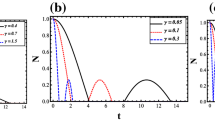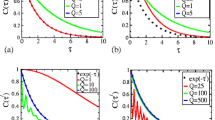Abstract
We investigate the decay of two-qubit entanglement caused by the influence of classical noise. We consider the whole spectrum of cases ranging from independent to fully correlated noise affecting each qubit. We take into account different spatial symmetries of noises, and the regimes of noise autocorrelation time. The latter can be either much shorter than the characteristic qubit decoherence time (Markovian decoherence), or much longer (approaching the quasi-static bath limit). We express the entanglement of two-qubit states in terms of expectation values of spherical tensor operators which allows for transparent insight into the role of the symmetry of both the two-qubit state and the noise for entanglement dynamics.






Similar content being viewed by others
Notes
The splitting renormalization is given by \(\varDelta \varOmega t = \int _0^t \hbox {d}t' \int _0^{t'} \hbox {d}t''\kappa (t'-t'')\sin \left[ \varOmega (t'-t'')\right] .\)
References
Steane, A.: Quantum computing. Rep. Prog. Phys. 61, 117 (1998)
Horodecki, R., Horodecki, P., Horodecki, M., Horodecki, K.: Quantum entanglement. Rev. Mod. Phys. 81, 865–942 (2009)
Leggett, A.J., Chakravarty, S., Dorsey, A.T., Fisher, M.P.A., Garg, A., Zwerger, W.: Dynamics of the dissipative two-state system. Rev. Mod. Phys. 59, 1 (1987)
Weiss, U.: Quantum Dissipative Systems. World Scientific, Singapore (1999)
Shimshoni, E., Gefen, Y.: Onset of dissipation in zener dynamics: relaxation versus dephasing. Ann. Phys. (NY) 210, 16 (1991)
Shimshoni, E., Stern, A.: Dephasing of interference in Landau-Zener transitions. Phys. Rev. B 47, 9523–9536 (1993)
Zurek, W.H.: Decoherence, einselection, and the quantum origins of the classical. Rev. Mod. Phys. 75, 715 (2003)
Aolita, L., de Melo, F., Davidovich, L.: Open-system dynamics of entanglement (2014). arXiv:1402.3713
Schoelkopf, R.J., Clerk, A.A., Girvin, S.M., Lehnert, K.W., Devoret, M.H.: Qubits as spectrometers of quantum noise. In: Nazarov, Y.V. (ed.) Quantum Noise in Mesoscopic Physics, pp. 175–203. Kluwer, Dordrecht (2003). (cond-mat/0210247)
Paladino, E., Galperin, Y.M., Falci, G., Altshuler, B.L.: \(1/f\) noise: implications for solid-state quantum information. Rev. Mod. Phys. 86, 361 (2014)
Fischer, J., Trif, M., Coish, W.A., Loss, D.: Spin interactions, relaxation and decoherence in quantum dots. Solid State Commun. 149, 1443 (2009)
Cywiński, Ł.: Dephasing of electron spin qubits due to their interaction with nuclei in quantum dots. Acta Phys. Pol. A 119, 576 (2011)
Monz, T., Schindler, P., Barreiro, J.T., Chwalla, M., Nigg, D., Coish, W.A., Harlander, M., Hänsel, W., Hennrich, M., Blatt, R.: 14-Qubit entanglement: creation and coherence. Phys. Rev. Lett. 106, 130506 (2011)
Schindler, P., Nigg, D., Monz, T., Barreiro, J.T., Martinez, E., Wang, S.X., Quint, S., Brandl, M.F., Nebendahl, V., Roos, C.F., Chwalla, M., Hennrich, M., Blatt, R.: A quantum information processor with trapped ions. New J. Phys. 15, 123012 (2013)
Makhlin, Y., Schön, G., Shnirman, A.: Dephasing of solid-state qubits at optimal points. Chem. Phys. 296, 315 (2004)
Pokrovsky, V.L., Sun, D.: Fast quantum noise in the Landau-Zener transition. Phys. Rev. B 76, 024310 (2007)
Duan, L.-M., Guo, G.-C.: Reducing decoherence in quantum-computer memory with all quantum bits coupling to the same environment. Phys. Rev. A 57, 737 (1998)
Burkard, G.: Non-Markovian qubit dynamics in the presence of \(1/f\) noise. Phys. Rev. B 79, 125317 (2009)
Yu, T., Eberly, J.H.: Qubit disentanglement and decoherence via dephasing. Phys. Rev. B 68, 165322 (2003)
Ting, Y., Eberly, J.H.: Sudden death of entanglement: classical noise effects. Opt. Commun. 264, 393 (2006)
Ann, K., Jaeger, G.: Disentanglement and decoherence in two-spin and three-spin systems under dephasing. Phys. Rev. B 75, 115307 (2007)
Ting, Y., Eberly, J.H.: Entanglement evolution in a non-Markovian environment. Opt. Commun. 283, 676 (2010)
Benedetti, C., Buscemi, F., Bordone, P., Paris, M.G.A.: Dynamics of quantum correlations in colored-noise environments. Phys. Rev. A 87, 052328 (2013)
Zhou, D., Lang, A., Joynt, R.: Disentanglement and decoherence from classical non-Markovian noise: random telegraph noise. Quantum Inf. Process. 9, 727 (2010)
Bellomo, B., Compagno, G., D’Arrigo, A., Falci, G., Lo Franco, R., Paladino, E.: Entanglement dynamics of two independent qubits in environments with and without memory. Phys. Rev. A 81, 062309 (2010)
Ban, M.: Entanglement, phase correlation and dephasing of two-qubit states. Opt. Commun. 281, 3943 (2008)
Corn, B., Ting, Y.: Modulated entanglement evolution via correlated noises. Quantum Inf. Process. 8, 565 (2009)
De, A., Lang, A., Zhou, D., Joynt, R.: Suppression of decoherence and disentanglement by the exchange interaction. Phys. Rev. A 83, 042331 (2011)
Brox, H., Bergli, J., Galperin, Y.M.: Bloch-sphere approach to correlated noise in coupled qubits. J. Phys. A Math. Theor. 45, 455302 (2012)
Budimir, J., Skinner, J.L.: On the relationship between \(t_{1}\) and \(t_{2}\) for stochastic relaxation models. J. Stat. Phys. 49, 1029 (1987)
Aihara, M., Sevian, H.M., Skinner, J.L.: Non-markovian relaxation of a spin-\(\frac{1}{2}\) particle in a fluctuating transverse field: cumulant expansion and stochastic simulation results. Phys. Rev. A 41, 6596 (1990)
Szańkowski, P., Trippenbach, M., Band, Y.B.: Spin decoherence due to fluctuating fields. Phys. Rev. E 87, 052112 (2013)
de Lange, G., Wang, Z.H., Ristè, D., Dobrovitski, V.V., Hanson, R.: Universal dynamical decoupling of a single solid-state spin from a spin bath. Science 330, 60 (2010)
Fox, R.F.: Application of cumulant techniques to multiplicative stochastic processes. J. Math. Phys. 15, 1479 (1974)
Falci, G., D’Arrigo, A., Mastellone, A., Paladino, E.: Initial decoherence in solid state qubits. Phys. Rev. Lett. 94, 167002 (2005)
Taylor, J.M., Lukin, M.D.: Dephasing of quantum bits by a quasi-static mesoscopic environment. Quantum Inf. Process. 5, 503 (2006)
Makhlin, Y., Shnirman, A.: Dephasing of solid-state qubits at optimal points. Phys. Rev. Lett. 92, 178301 (2004)
Cywiński, Ł.: Dynamical-decoupling noise spectroscopy at an optimal working point of a qubit. Phys. Rev. A 90, 042307 (2014)
Życzkowski, K., Horodecki, P., Horodecki, M., Horodecki, R.: Dynamics of quantum entanglement. Phys. Rev. A 65, 012101 (2001)
Ting, Y., Eberly, J.H.: Finite-time disentanglement via spontaneous emission. Phys. Rev. Lett. 93, 140404 (2004)
Ting, Y., Eberly, J.H.: Sudden death of entanglement. Science 323, 598 (2009)
Wootters, W.K.: Entanglement of formation of an arbitrary state of two qubits. Phys. Rev. Lett. 80, 2245 (1998)
Ashm, R.B.: Basic Probability Theory. Dover, New York (2008)
Sakurai, J.J.: Modern Quantum Mechanics. Addison Wesley, London (1994)
Ting, Y., Eberly, J.H.: Evolution from entanglement to decoherence of bipartite mixed “x” states. Quantum Inf. Comput. 7, 459 (2007)
Horodecki, R., Horodecki, M.: Information-theoretic aspects of inseparability of mixed states. Phys. Rev. A 54, 1838–1843 (1996)
Hill, S., Wootters, W.K.: Entanglement of a pair of quantum bits. Phys. Rev. Lett. 78, 5022 (1997)
Aolita, L., de Melo, F., Davidovich, L.: Open-system dynamics of entanglement. Rep. Prog. Phys. 78, 042001 (2015)
Szańkowski, P., Trippenbach, M., Chwedeńczuk, J.: Parameter estimation in memory-assisted noisy quantum interferometry. Phys. Rev. A 90(6), 063619 (2014)
Feynman, R.P.: An operator calculus having applications in quantum electrodynamics. Phys. Rev. 84, 108 (1951)
Kubo, R.: Generalized cumulant expansion method. J. Phys. Soc. Jpn. 17, 1100 (1962)
Van Kampen, N.G.: A cumulant expansion for stochastic linear differential equations. I. Physica 74, 215 (1974)
Van Kampen, N.G.: A cumulant expansion for stochastic linear differential equations. II. Physica 74, 239 (1974)
Fox, R.F.: Critique of the generalized cumulant expansion method. J. Math. Phys. 17, 1148 (1976)
Zhou, D., Chern, G.-W., Fei, J., Joynt, R.: Topology of entanglement evolution of two qubits. Int. J. Mod. Phys. B 26, 1250054 (2012)
Blum, K.: Density Matrix Theory and Applications. Plenum Press, New York (1981)
Wang, M.C., Uhlenbeck, G.E.: On the theory of the Brownian motion II. Rev. Mod. Phys. 17, 323 (1945)
Lidar, D.A.: Review of decoherence free subspaces, noiseless subsystems, and dynamical decoupling. Adv. Chem. Phys. 154, 295–354 (2014)
Bergli, J., Galperin, Y.M., Altshuler, B.L.: Decoherence of a qubit by a non-Gaussian noise at an arbitrary working point. Phys. Rev. B 74, 024509 (2006)
Benedetti, C., Paris, M.G.A.: Effective dephasing for a qubit interacting with a transverse classical field. Int. J. Quantum Inf. 12, 1461004 (2014)
Cucchietti, F.M., Paz, J.P., Zurek, W.H.: Decoherence from spin environments. Phys. Rev. A 72, 052113 (2005)
Dobrovitski, V.V., Feiguin, A.E., Hanson, R., Awschalom, D.D.: Decay of rabi oscillations by dipolar-coupled dynamical spin environments. Phys. Rev. Lett. 102, 237601 (2009)
Bragar, I., Cywiński, Ł.: Dynamics of entanglement of two electron spins interacting with nuclear spin baths in quantum dots. Phys. Rev. B 91, 155310 (2015)
Shulman, M.D., Harvey, S.P., Nichol, J.M., Bartlett, S.D., Doherty, A.C., Umansky, V., Yacoby, A.: Suppressing qubit dephasing using real-time hamiltonian estimation. Nat. Commun. 5, 5156 (2014)
Hung, J.-T., Cywiński, Ł., Xuedong, H., Das Sarma, S.: Hyperfine interaction induced dephasing of coupled spin qubits in semiconductor double quantum dots. Phys. Rev. B 88, 085314 (2013)
DArrigo, A., Mastellone, A., Paladino, E., Falci, G.: Effects of low-frequency noise cross-correlations in coupled superconducting qubits. New J. Phys. 10, 115006 (2008)
Acknowledgments
This work was supported in part by grants from the Israel Science Foundation (Grant No. 295/2011). P. Sz. acknowledges the Foundation for Polish Science International Ph.D. Projects Program co-financed by the EU European Regional Development Fund. ŁC was supported and P. Sz was partially supported by funds of Polish National Science Center (NCN), Grant No. DEC-2012/07/B/ST3/03616.
Author information
Authors and Affiliations
Corresponding author
Appendices
Appendix 1: Concurrence of the Bell States
The density matrices of the \(X_{\mathrm {corr}}\)-states, written in standard two-qubit basis \(\{ \left| \uparrow \downarrow \right\rangle ,\left| \downarrow \uparrow \right\rangle ,\left| \uparrow \uparrow \right\rangle ,\left| \downarrow \downarrow \right\rangle \}\), have a form
where the condition \(2a+2b=1\) insures that the trace equals unity. Matrices of the form (91) are time reversal invariant, hence the concurrence is easily evaluated because it can be expressed in term of eigenvalues of \(\varrho \) itself. These eigenvalues can be determined analytically, so the concurrence is given by [45]
Straightforward calculations show that the matrix elements \(a,\,b,\,w\) and z can be written in terms of the expectation values of products of the spherical tensor operators,
Thus we obtain formula (27).
Appendix 2: Diagonalization of the evolution superoperator for the case of transverse noise
The evolution superoperator for transverse white noise is given by Eq. (71):
where we introduced the superoperator \({\mathcal {L}}\) defined as
Our task is to diagonalize the matrix representation of this superoperator. The matrix elements in the basis of spherical tensor products are
where \((A|B)=\mathrm {Tr}( A^\dagger B)\) and \(||A||=\sqrt{(A|A)}\). The explicit form of the matrix is given by

where blank spaces are zero. The matrix has a block-diagonal form and each block can be diagonalized analytically. In particular, spherical tensor products \(T^{(1)}_{1 \pm 1}\otimes T^{(2)}_{1 \pm 1} = T_{2\pm 2(11)}\) are already eigenoperators of \({\mathcal {L}}\) and the triple of unpolarized products \(\{ T^{(1)}_{1 0}~{\!\!\otimes \!}~ T^{(2)}_{1 0},T^{(1)}_{1 1}~{\!\!\otimes \!}~T^{(2)}_{1 {-1}},T^{(1)}_{1 {-1}}~{\!\!\otimes \!}~ T^{(2)}_{1 1} \}\) form one of the blocks. Because the \(X_{\mathrm {corr}}\)-states (including the Bell states) are spanned by these five operators, it follows that any state which belongs to this class remains in it for all time when it is evolved with \({\mathcal {U}}_{\mathrm {tr}}\).
Below we list the eigenoperators and the corresponding eigenvalues of \({\mathcal {L}}\):
where \(\eta = \frac{1}{3}\sqrt{1+8\gamma ^2}\).
Rights and permissions
About this article
Cite this article
Szańkowski, P., Trippenbach, M., Cywiński, Ł. et al. The dynamics of two entangled qubits exposed to classical noise: role of spatial and temporal noise correlations. Quantum Inf Process 14, 3367–3397 (2015). https://doi.org/10.1007/s11128-015-1044-7
Received:
Accepted:
Published:
Issue Date:
DOI: https://doi.org/10.1007/s11128-015-1044-7




